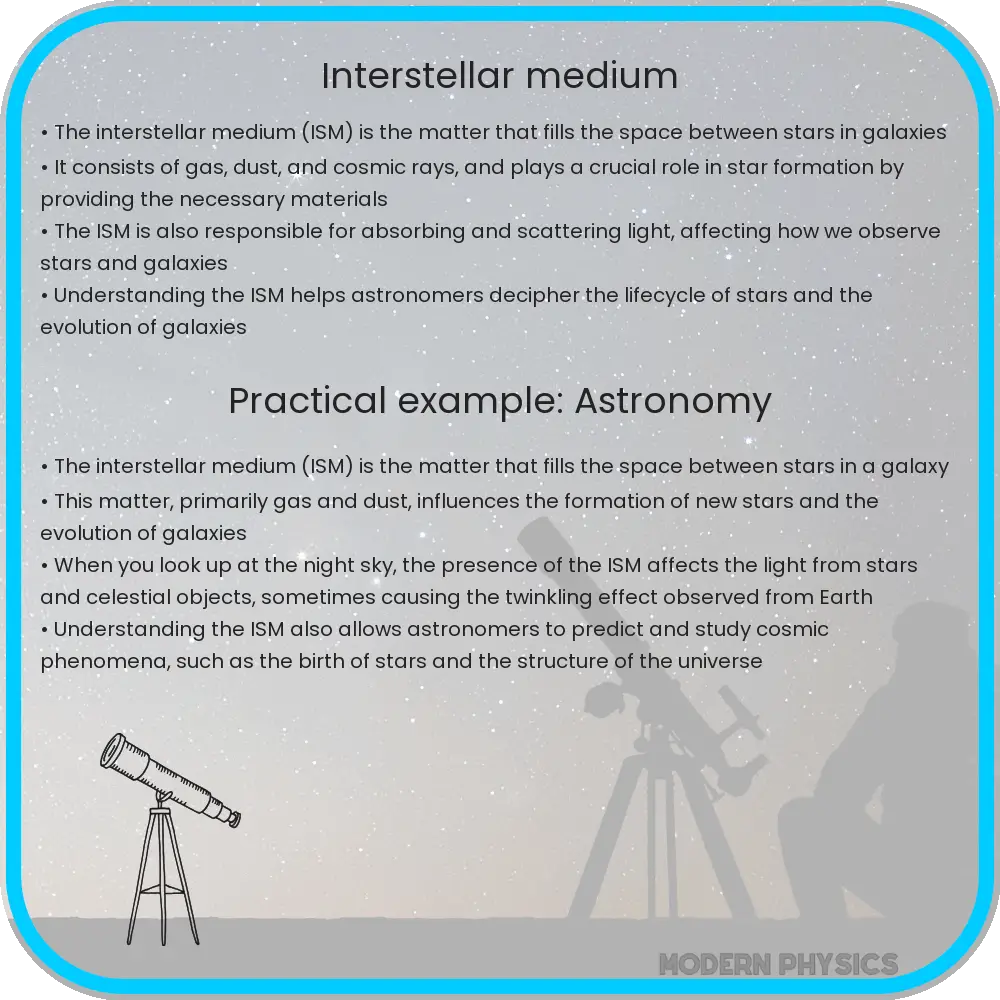Explore the mysteries, composition, and dynamics of the Interstellar Medium (ISM), the essential cosmic substance filling the space between stars in galaxies.

Exploring the Enigmatic Interstellar Medium
The Interstellar Medium (ISM) is a vast, complex, and dynamic space that exists between the stars within galaxies. This enigmatic expanse is not an empty void but filled with a mixture of gas, dust, and cosmic rays, which play a crucial role in the life cycle of stars and the evolution of galaxies. Understanding the mysteries, composition, and dynamics of the ISM is essential for astronomers and astrophysicists to piece together the cosmic puzzle of our universe.
Composition of the Interstellar Medium
The ISM is primarily composed of hydrogen, the most abundant element in the universe, existing in various forms: atomic hydrogen (H), molecular hydrogen (H2), and ionized hydrogen (H+). Helium, the second most abundant element, complements this composition along with traces of heavier elements such as carbon, nitrogen, and oxygen. These elements are found in different phases: the cold, warm, and hot interstellar medium, each with distinct characteristics and temperatures ranging from just a few Kelvin to several million degrees.
The Mysteries of Dust and Cosmic Rays
Interstellar dust, though comprising only about 1% of the ISM by mass, has a profound impact on the galaxy. These tiny grains, composed of elements like carbon and silicon, absorb and scatter starlight, influencing the energy balance within the galaxy and aiding in the formation of new stars by cooling and condensing the surrounding gas. Moreover, the ISM is permeated by cosmic rays, high-energy particles that traverse space at nearly the speed of light, influencing the chemical reactions within the ISM and contributing to the complex dynamics of the galactic ecosystem.
Dynamic Processes within the Interstellar Medium
The dynamics of the ISM are governed by gravitational forces, stellar winds, supernovae explosions, and magnetic fields. These forces interact in a complex ballet, shaping the structure and motion of the interstellar matter. The life cycle of stars, from their birth in dense molecular clouds to their explosive deaths as supernovae, profoundly influences the ISM, recycling material and driving the chemical enrichment of the galaxy.
Understanding the Interstellar Medium: A Cosmic Perspective
The Interstellar Medium (ISM) is the physical substance that fills the space between the stars within galaxies. Comprising various forms of matter, including gas, dust, and cosmic rays, the ISM plays a crucial role in the lifecycle of stars and the overall dynamics of galaxies. Understanding its composition and dynamics is essential for unraveling the mysteries of the universe.
Composition of the Interstellar Medium
The ISM is primarily made up of hydrogen and helium, with hydrogen existing in atomic (H), molecular (H2), and ionized (H+) forms. Besides these primary components, there are trace amounts of other elements such as carbon, nitrogen, and oxygen, along with more complex molecules and dust grains composed of silicates and carbon-based compounds. These elements and molecules are the building blocks of star and planet formation, making the study of ISM composition fundamental to astrophysics.
Dynamics of the Interstellar Medium
The dynamics of the ISM are influenced by gravitational forces, radiation pressure, magnetic fields, and feedback from star formation. These forces shape the structure and properties of the ISM, leading to the formation of molecular clouds, H II regions, and other interstellar structures. The balance between the processes of star formation and the injection of energy from stars into the ISM drives the evolution of galaxies.
Mysteries of the Interstellar Medium
Despite significant advances, many mysteries remain about the ISM. The exact processes behind the formation and destruction of molecular clouds, the impact of magnetic fields on interstellar dynamics, and the role of dark matter within the ISM are subjects of ongoing research. Additionally, the origins of cosmic rays and their interactions with interstellar matter continue to puzzle scientists.
In conclusion, the Interstellar Medium is a complex and dynamic component of the universe, integral to the lifecycle of stars and the evolution of galaxies. Its study not only helps us understand the cosmos at large but also provides insights into the fundamental processes underlying star and planet formation. As technology advances, new observations and models continue to shed light on the mysteries of the ISM, bringing us closer to a comprehensive understanding of our galaxy and beyond.
